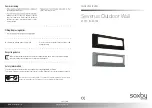
1—2
Page 2
Wing Tanks
2. There are three tanks in each wing, numbered (from the wing root
outwards): 1, 2 and 3. The fuel tanks are also referred to as Inboard,
Outboard and Reserve tanks respectively. No. 1 tanks are located
between the fuselage and the inboard engines, No. 2 tanks between the
inboard and outboard engines and No. 3 tanks outboard of the outboard
engines. No. 1 and 2 tanks are the main tanks. The tanks are made from
aluminium and coated with foam and fabric. They are not self sealing.
The hydraulically operated fuel jettison system is inoperative. Each tank
has its own vent pipe, which connects the top of the tank to atmosphere
through an outlet on the underside of the wing.
3. The tank capacities and minimum landing fuels are:
Tank
Capacity (gallons)
Min Landing Fuel
(gallons)
Tank
Aircraft
Tank
Aircraft
1
580
1160
20
40
2
383
766
20
40
3
114
228
0
0
Totals
1077
2154
40
80
Fuel Gauging
4. Each tank has its own gauging system. A float type sensor in each
tank sends a signal to a tank gauge on the Flight Engineer’s fuel panel.
Each gauge is calibrated in gallons and has two scales: Red, for tail
down attitudes (for use on the ground) and white for use in flight. Each
pair of tank gauges has a different scale and are poorly ‘damped’ making
them difficult to read accurately. The gauges are powered through a
common, multi-function Instrument Master switch (marked OFF/ON) on
the Flight Engineer’s panel, which is protected by a circuit breaker on
the main electrical panel.
5. Individual ta
nk dipsticks are stowed aft of the rear door on the starboard
side of the aircraft. Each stick, calibrated in gallons, can only be used when
the tank is over half-full because of its length. Therefore, it is imperative,
that fuel consolidation checks are carried out post refuelling.
UNCONTROLLED DOCUMENT - NOT FOR USE IN FLIGHT OR TO BE PRINTED
UNCONTROLLED DOCUMENT - NOT FOR USE IN FLIGHT OR TO BE PRINTED
















































